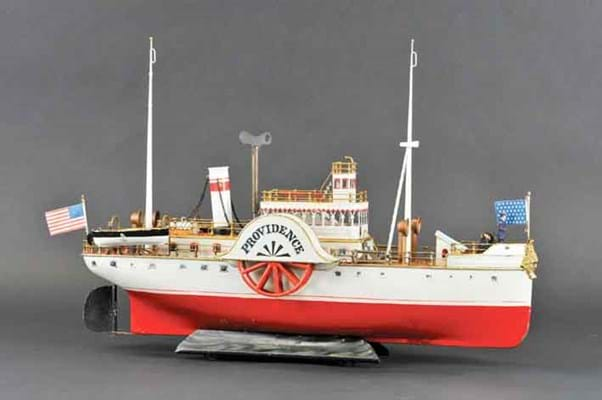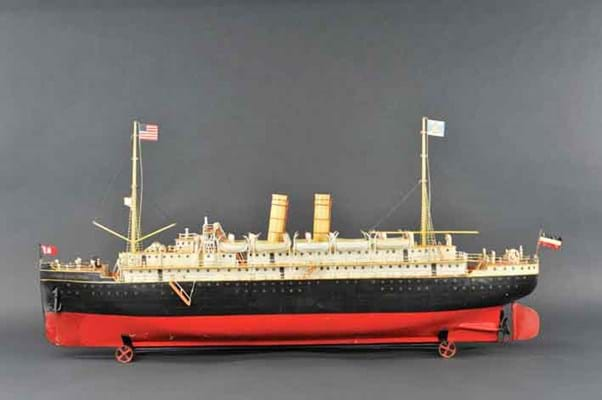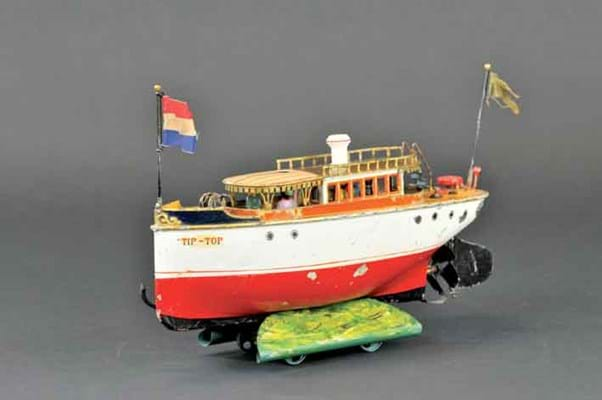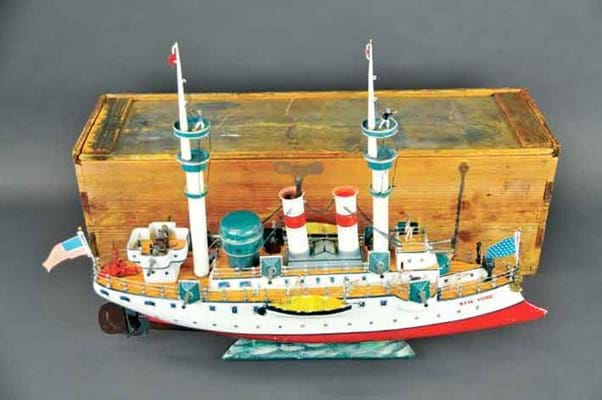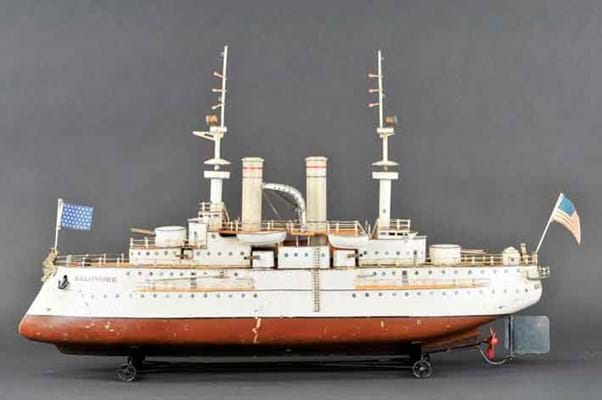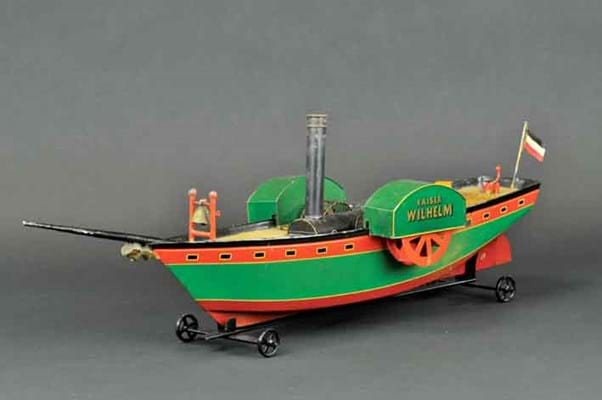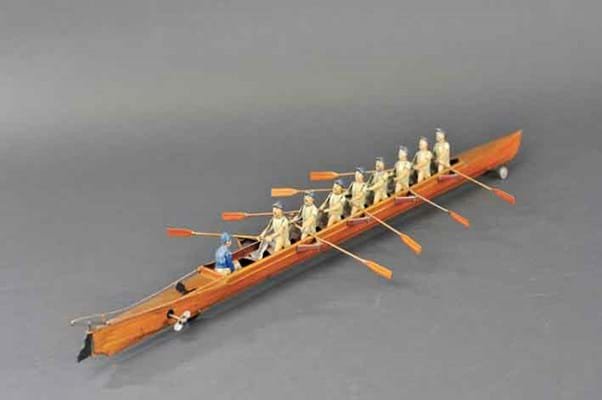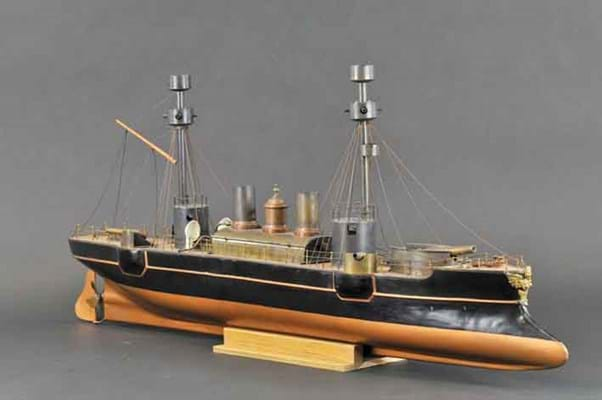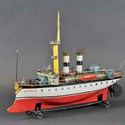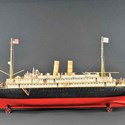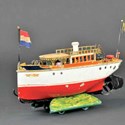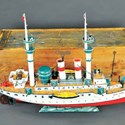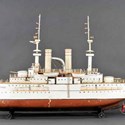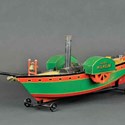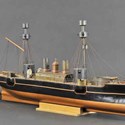A Pennsylvanian chemical wholesaler with an encyclopaedic knowledge of his 30-year hobby - his 2005 volume presents a complete and unbroken timeline of toy boat-making across two centuries - Dick Claus was also a stickler for condition and looked to upgrade from good to great whenever possible.
As he narrowed down his collection after publication of the book, the result was the cream of tinplate boats by premier European manufacturers.
The other result was a sale which the Vineland, New Jersey specialists Bertoia Auctions will long remember, alongside the $12.1m, five-part Donald Kaufman collection, as among their very best.
To benefit the bank balances of both buyers and seller, the collection is being offered in two tranches. The first offering of 210 lots sold across two hours was on May 12 - the rest will go under the hammer on November 10.
Part I of the Richard T. Claus collection was the second major sale of European tinplate boats in the space of as many years. Who can forget the huge Forbes collection at Sotheby's New York in December 2010, when, among so many yachts, battleships and liners by the likes of Rock and Graner, Carette, Bing and Fleishman, a Märklin model of the Lusitania made $160,000 (£106,670)? Certainly not Dick Claus who was actively bidding at the sale. "Once a collector, always a collector," commentated Rich Bertoia.
On a smaller scale in the UK, the Ron McCrindell collection was sold by Special Auction Services of Greenham, near Newbury in April when a c.1904 Märklin 'first series' battleship, HMS Terrible, went to a Belgian telephone bidder at £76,000.
So was there a risk of flooding the market? In a word, No.
The Claus material was just too good to miss and more than 100 bidders (many of them from Europe) reserved seats at Bertoia's gallery, while scores of others waited patiently either by their phones or computers to bid online through Live Auctioneers.
Already $1.8m (£1.2m) is in the bag - a cool half a million dollars more than the pre-sale high estimate of $1.3m (£860,700).
There were boats here by a full cross section of European makers from the familiar to the obscure, but it is difficult to look beyond the veritable fleet from the fabled Göppingen factory, Gebruder Märklin.
Combining the best of man and machine in their production methods, Märklin boats from the first decade of the 20th century rank among the most elegant, the most colourful and the most expensive tin toys ever made. Most collectors dream of owning just one. Dick Claus had dozens.
Made during the first flowering of Märklin's creative genius c.1902 was a 2ft 2in (65cm) riverboat titled Providence to the side paddle and (like many of the boats in this sale) dressed with the Stars and Stripes for the American market. Alongside the Märklin paddle steamer Chicago (featured on the dust jacket of Claus's book and for sale come the autumn) it is among the best-known toys in the collection and last on the market in 2007 when sold by Noel Barrett for $90,000.
It is detail that separates Märklin from the many other German productions of the period and here nothing was overlooked: cabin windows with painted curtains, a funnel held steady by chains, lifeboats (one a replacement) hung on davits and a captain standing on the prow deck. It was one of three majestic boats in the Part I sale to carry a six-figure estimate but in fact doubled hopes at $215,000 (£143,350) - a record for a tinplate boat at auction.
The buyer was in the room and bidding on behalf of a US collector.
Of those who actually won items, Bertoia said it was a 50-50 split between European and US buyers.
The largest models in the Märklin fleet, larger indeed than the aforementioned Lusitania model c.1912 that measured 3ft 2in (96cm), were the series of ocean-going liners measuring a massive 3ft 10in (1.17m).
A battery-driven model of this size was recently offered by James D. Julia in Maine but that in the Claus collection was powered by a very sturdy steam engine and replicated the vessel billed as the largest of its age, the Hamburg-America Line's Kaiserin Auguste Victoria.
Again, this was packed with detail - as Claus points out in his book, even minute life preservers hang on the rail across from the pilot's house - and it had received the minimum of restoration. Having purchased it at auction in upstate New York, Dick Claus later learnt that it had been stored for decades in a dry barn and probably had never been played with. At Vineland it went on its top estimate of $120,000 (£80,000).
At just over 12in (30cm) long, a battery-powered Tip Top yacht was the smallest in a series of luxury private yachts made by Märklin and it includes some great detail - particularly a canopy-covered dining section with passengers seated around a table.
The example in the Forbes collection, with an unusual brown and orange striped hull, had sold at $15,000. This example, with a more typical red and white hull and the small stack replaced, took a treble-estimate $32,000 (£21,350).
It is often said wistfully that the lakes and ponds of the western world are carpeted with the rusting hulks of fine tinplate boats.
Certainly, given the unhappy mix of ferrous metal and water, the few survivors that have escaped significant restoration command a substantial premium.
Among the gems of the Claus collection was a 'first series' battleship, the New York from the 'sweet spot' years around 1905. One mast was a replacement, but this 2ft 4in (71cm) vessel was otherwise in superb condition, retaining all its original paint, multiple guns, a fully appointed deck and its original pine box.
Estimated at $50,000-60,000, it made $95,000 (£63,350) - close to twice the $47,500 taken for a very similar New York gunship of this period in lesser condition at the Forbes sale.
While boats were sold under the Märklin name in the 1890s, most were derivatives of models by Ludwig Lutz, the rival toymaker in Ellwangen which Märklin acquired in 1891.
Accordingly, it is the boats that appeared in the earliest years of the new century, superbly made if slightly naive interpretations of real warships, which collectors have traditionally called first generation Märklin models. Those made after around 1909, often more sophisticated in design but painted in more muted colours, are dubbed second generation vessels.
A number of second series American market battleships were deemed exceptional survivors.
These included the 3ft (91cm) maroon and grey hull Maryland (estimate $50,000-60,000) with multiple gun turrets, a four-tiered mast and multiple observation decks, which was modelled after the Normandie class of Dreadnoughts ordered for the French Navy in 1912-1913, and the well-appointed 3ft 2in (96cm) Brooklyn in two-tone grey c.1913 (estimate $90,000-120,000).
Both with little to count against them save very minor restoration, they sold at $125,000 (£83,350) and $90,000 (£60,000) respectively.
In a sale where the average lot price was more than $8500, Märklin handiwork provided seven of the top ten prices.
However, forcing its way into sixth position was one of the earliest boats in the collection, a steam-driven paddle steamer c.1875. The name Kaiser Wilhelm appears on the paddle wheel covers while details include a figurehead and bow spirit that add another 6in (15cm) to the overall length of 21in (53cm).
Traditionally, this model, painted in green, orange, black and maroon, and others like it were attributed to the aforementioned Lutz factory, but the relatively recent discovery of a catalogue from the years 1876-81 has seen them rebranded as the products of the Rock and Graner factory.
Again in excellent condition, with just minor enhancement to the paddle wheels and the red bell lever, Kaiser Wilhelm sold above hopes at $40,000 (£26,650).
Gunthermann Models
Another well-known German factory to feature strongly in the sale was Gunthermann whose output included a lithographed-tin model of an eight-man racing scull with a uniformed crew and blue-jacketed coxswain.
Measuring an impressive 2ft 5in (74cm) long, it is an exceptionally detailed toy with a clockwork mechanism providing a synchronised rowing action.
Johann Issmayer of Nuremberg also made a version of this toy, designed to run on the floor rather than on water, available with either a light blue crew for Cambridge or a dark blue crew for Oxford. Here the rowers wear rather more ambiguous blue and white vests and the hull is finished in a light brown wood grain.
The model is illustrated across the collecting literature but has been an elusive sight at auction in recent years. It streaked past its $10,000-$12,000 estimate to cross the line at $27,500 (£18,350).
Radiguet Boat
The one non-German boat to feature among the top lots was a live-steam gunboat by Radiguet. The celebrated French makers specialised in scientific teaching aids but began making these steam-powered toy boats, characterised by their black- and gold-painted hulls with wood and brass fittings, in the 1880s.
At 3ft 3in (99cm) from its elongated ram bow to stern, the gunboat was larger than the example owned by Malcolm Forbes but shared its form and details: brass cannon, a two-tiered crow's nest, full rope railing and an elaborate centre deck boiler with two funnel stacks. Its hull was repainted but it still doubled hopes at $32,000 (£21,350). Forbes' 2ft 6in (76cm) model had sold for $29,000.
A further 300 lots are anticipated for the second Claus sale with a pre-sale estimate of approximately $1.2m.
The buyer's premium at Bertoia Auctions was 15%.
£1 = $1.50

